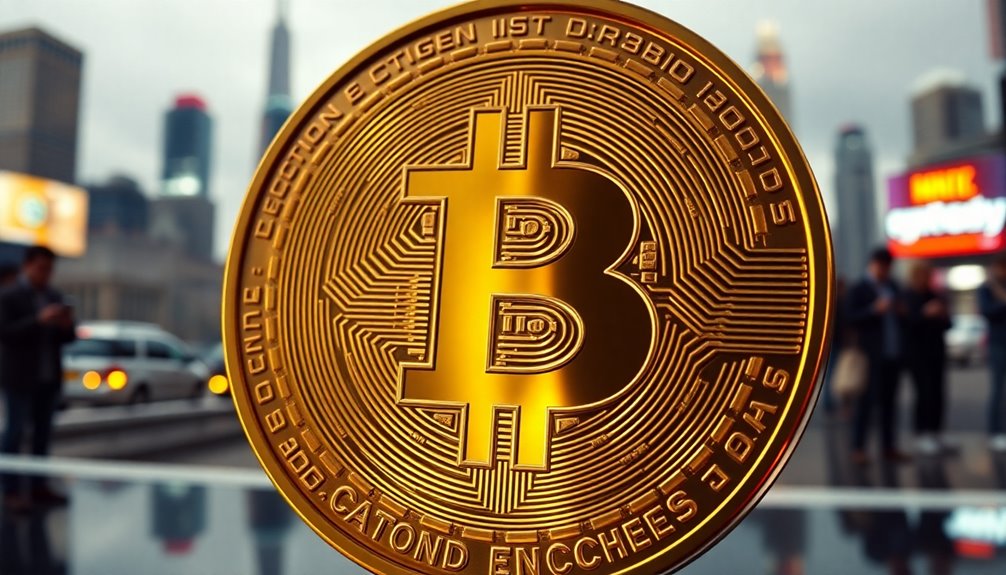Bitcoin adoption's outpacing both the Internet and mobile phones, especially among younger users. This trend's fueled by rising inflation and geopolitical tensions, which make Bitcoin an attractive decentralized asset. Infrastructure supporting digital assets is now mature, making it easier for you to embrace this technology. With anticipated regulatory changes promoting transparency, Bitcoin's appeal is only set to grow. As you explore its connection to market trends and upcoming election cycles, you'll see how this digital currency is becoming a key part of the financial landscape. There's much more to discover about Bitcoin's remarkable trajectory.
Key Takeaways
- Bitcoin adoption is rapidly increasing among younger generations, surpassing previous technological innovations like the internet and mobile phones.
- In India alone, there are 75 million Bitcoin users, indicating strong global interest in digital assets.
- Bitcoin's appeal is heightened by rising inflation and geopolitical tensions, positioning it as a decentralized alternative to traditional currencies.
- The maturity of digital asset infrastructure has lowered barriers, making Bitcoin more accessible to a wider demographic.
- Regulatory changes are expected to promote transparency, further encouraging mainstream adoption of Bitcoin.
Bitcoin's Rapid Growth Trajectory

As Bitcoin continues to gain traction, you'll find its rapid growth trajectory is fueled by several key factors.
Younger generations, often called “digital natives,” are leading the charge in adoption, as they’re comfortable with technology and prefer digital solutions over traditional assets. This demographic shift is significant, with older generations like Gen X and Baby Boomers lagging behind. Moreover, countries like India with 75 million users show a strong interest in digital assets, reflecting a global trend towards cryptocurrency adoption. This growing interest in digital assets is not just about investment; it also encompasses a shift towards greater ownership and control over one’s finances. The notion of selfcustody in cryptocurrency is becoming increasingly popular, as younger individuals prioritize security and autonomy in managing their wealth. As they move away from traditional banking systems, they are redefining financial independence in a digital age, leveraging tools and technologies that empower them to take charge of their assets.
Economic shifts, such as rising inflation and geopolitical tensions, further highlight Bitcoin's appeal as a decentralized asset. Its independence from central authorities resonates with those seeking financial stability.
Additionally, the maturation of digital asset infrastructure has lowered barriers to entry, making Bitcoin more accessible and integral to the evolving financial landscape, driving sustained interest and investment.
Regulatory Changes Impacting Bitcoin

Bitcoin's growing prominence in the financial landscape is now being shaped by a wave of regulatory changes.
The SEC is set to revise Staff Accounting Bulletin 121, which could alter how crypto firms report their activities. This move aims to foster an innovation-first environment while addressing concerns about debanking. As part of this initiative, regulators are expected to reconsider custody standards for crypto assets to ensure they align with industry needs.
Additionally, new Treasury regulations will require centralized exchanges to report transactions using Form 1099-DA in 2025, extending similar standards to decentralized operators.
The EU's MiCA regulation offers a comprehensive approach to digital asset oversight, while the incoming Trump administration plans to appoint pro-crypto officials.
These developments signal a shift toward greater transparency and accountability in the crypto space, impacting how you engage with Bitcoin and its ecosystem.
Bitcoin Price Volatility Analysis

While many investors are drawn to Bitcoin for its potential as a store of value, its price volatility can be a double-edged sword. Factors like supply and demand dynamics play a crucial role, especially with Bitcoin's fixed supply of 21 million coins. When demand spikes, prices surge, but they can plummet just as quickly when interest wanes. Interestingly, Bitcoin's one-year realized volatility has reached historic lows, suggesting a calmer market environment. This low volatility often sets the stage for future price increases. In fact, historical trends indicate that low volatility can often precede significant price rises. Regulatory changes and investor sentiment also significantly influence Bitcoin's price, as seen during the anticipation of potential ETF approvals. Ultimately, understanding these dynamics helps you navigate Bitcoin's unpredictable landscape.
Corporate Investment Strategies

Understanding corporate investment strategies is crucial for navigating today's dynamic financial landscape. Focus on the U.S. market, as analysts predict a stronger economy and rising S&P 500 Index in 2025, driven by stock earnings growth. High-quality U.S. bonds with maturities of 4 to 10 years are favored for fixed-income strategies. With Bitcoin adoption rates exceeding those of previous technological advancements, it's essential to consider how this may influence future corporate investment decisions. Keep an eye on tax implications, especially capital gains, if you're a high-net-worth investor. Globally, moderate growth and disinflation present opportunities, particularly in U.S. and Japanese equities. Consider diversifying your portfolio with alternative investments, utilizing tax-loss harvesting strategies to optimize performance.
Election Cycles and Bitcoin Trends

As the financial landscape evolves, election cycles can significantly impact investment trends, including those in Bitcoin.
Historically, Bitcoin has mirrored the S&P 500's performance, often rallying post-elections. For instance, after Trump's 2016 victory, Bitcoin soared from $720 to nearly $20,000. Following Biden's 2020 win, it jumped from $16,300 to $69,000. The correlation between Bitcoin and the S&P 500 often strengthens during bull cycles, suggesting that Bitcoin may follow traditional market trends closely. Additionally, investors should consider diversifying investments to manage risks associated with the volatility of cryptocurrencies.
The 2024 election cycle is already generating buzz, with expectations for further price increases. Younger voters, who'll make up 44% of the electorate, are more likely to embrace Bitcoin, driven by their tech-savvy nature and distrust of traditional institutions.
This demographic shift could shape crypto policies and influence Bitcoin's trajectory as elections unfold, making it crucial to watch these trends closely.
Long-Term Bitcoin Adoption Trends

Long-term Bitcoin adoption trends reveal a dynamic transformation in how different demographics interact with this digital asset.
Younger generations, often termed "digital natives," lead the way with their comfort in technology and preference for digital solutions. This shift in demographics is significant, as Gen X and Baby Boomers lag in adoption. Recent reports indicate that there are over 200 million Bitcoin users globally, highlighting the rapid uptake among various age groups.
Economic factors like rising inflation and geopolitical tensions boost Bitcoin's appeal as a decentralized asset, especially amid traditional banking instability.
The maturation of digital asset infrastructure lowers entry barriers, fostering new use cases. Additionally, institutional interest is growing, with substantial inflows into spot U.S. Bitcoin ETFs.
As retail investors drive much of this momentum, the future market is poised for significant growth, potentially managing trillions by 2033.
Frequently Asked Questions
What Are the Environmental Impacts of Bitcoin Mining?
Bitcoin mining has significant environmental impacts.
You'll notice its high energy consumption, estimated at around 87 TWh annually, mostly from fossil fuels, resulting in considerable carbon emissions. Each dollar mined causes climate damage, potentially more than other industries.
Additionally, mining generates substantial electronic waste due to hardware's short lifespan and has a massive water footprint.
Exploring sustainable practices is crucial to mitigate these effects and support renewable energy initiatives.
How Can I Safely Store My Bitcoin?
Did you know that over 70% of Bitcoin is stored in cold wallets?
To safely store your Bitcoin, use non-custodial cold hardware wallets, as they're offline and secure. Regularly back up your wallet and keep large amounts offline to deter thieves.
For hot wallets, enable two-factor authentication and only connect to the internet when necessary. Always monitor wallet activity and avoid public Wi-Fi to enhance your security.
What Is the Role of Bitcoin in Remittances?
Bitcoin plays a significant role in remittances by reducing costs, speeding up transactions, and enhancing accessibility.
You can save money on fees compared to traditional methods, often paying just $1.50 per transaction. Additionally, Bitcoin allows you to send funds almost instantly, which is crucial for urgent transfers.
Its decentralized nature also means you can transact without needing a bank, making it easier for everyone, regardless of their financial situation, to participate.
Are There Bitcoin Alternatives Worth Considering?
Imagine you're exploring investment options, and you come across Ethereum.
It's not just a Bitcoin alternative; it's crucial for decentralized projects.
With a market cap of $412 billion, Ethereum's expected spot ETF approval in 2025 could open new doors for you.
Altcoins like Solana and XRP also show promise, despite regulatory hurdles.
How Does Bitcoin Affect Traditional Banking Systems?
Bitcoin significantly impacts traditional banking systems by enabling direct peer-to-peer transactions, cutting out intermediaries like banks.
You benefit from reduced transaction fees and increased control over your finances through digital wallets.
However, this disrupts banks' revenue streams, forcing them to adapt or risk losing customers.
As financial accessibility improves globally, you'll find that Bitcoin and other cryptocurrencies provide options that traditional banking often can't match, pushing banks to innovate and compete.
Conclusion
As you look at Bitcoin's rapid growth, remember how the internet and mobile phones once transformed our lives. Just as those technologies faced skepticism and regulatory hurdles, Bitcoin's journey is no different. With corporations investing heavily and governments adapting, you're witnessing a potential revolution. While price volatility may cause concern, the long-term adoption trends suggest Bitcoin could soon become as integral to our daily lives as the devices we can't live without.









